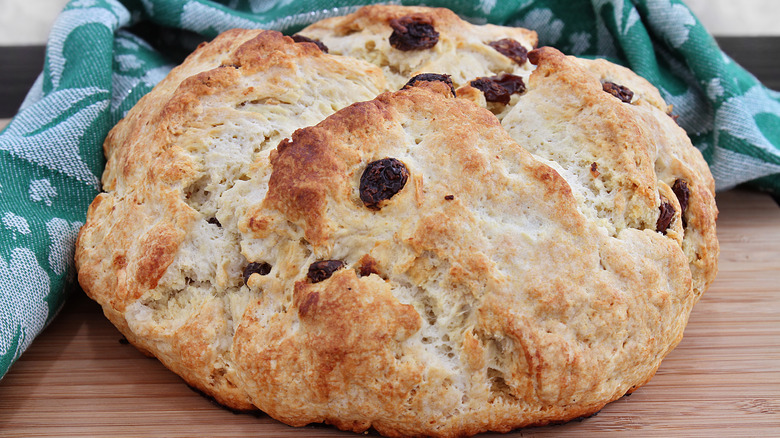The Frugal Origins Of Irish Soda Bread
In both the U.S. and Ireland, Irish soda bread is associated with the weeks surrounding St. Patrick's Day each year. So, demand for the sturdy, peasanty bread tends to peak in these countries in the weeks leading up to March 17, the day that the real St. Patrick is said to have died during the 5th century. In Ireland, however, demand for Irish soda bread remains high throughout the entire year. That's because many Irish households regard Irish soda bread as a mealtime staple. Indeed, as Trafalgar points out, a crusty chunk of Irish soda bread makes for a sturdy and toothsome implement for soaking up the last of one's stew — kind of how Southern-style biscuits can be used to artfully snag that last bit of gravy or how sticky rice can act as an efficient delivery system for putting every last drop of your tom yum soup to good use.
It's easy to assume that Irish soda bread — (aka Irish brown soda bread when it's made the traditional way, using wholemeal flour, which contains bits of the wheat's bran and germ) — was introduced during the times of St. Patrick himself. However, there's no evidence to suggest that Maewyn Succat, the man who would become St. Patrick, had any knowledge of the chemistry-driven magic that makes Irish soda bread one of the simplest, least expensive breads one can make. Let's take a look at that magic and how it figures into Irish soda bread's frugal origins.
Irish soda bread grew popular during famine
Irish soda bread requires no eggs, yeast, sugar, kneading, or rising. At its simplest, it's just four ingredients: flour, salt, baking soda, and soured milk (aka buttermilk). Saving both time and money, Irish Soda Bread is, therefore, exceptionally frugal. And it's all thanks to the scientific fact that when baking soda (an alkaline powdery substance also known as bicarbonate of soda) interacts with soured milk (an acidic substance thanks to the lactic acid that multiplies as milk leaves its freshest state), the result is effervescence. In other words: lots and lots of tiny bubbles.
Irish soda bread developed out of a need to make use of all food, even after it had begun to spoil (e.g., soured milk). The first recipes date back to the mid-1830s when Ireland was still reeling from Britain's late 17th-century invasion and continuing occupation, which saw Ireland's farmlands divvied among new British landlords but worked by local families, per Borgen Project. Multiple families were often assigned to a single tract, resulting in a scarcity of resources, especially food.
It was in this context someone thought to use their soured milk to make a yeast-less, eggless, four-ingredient bread –just by adding baking soda and rounding it out with some flour and salt. The resulting Irish soda bread caught on slowly, but it truly came into its own during the potato famine, which began in 1845 and continued until 1850.

